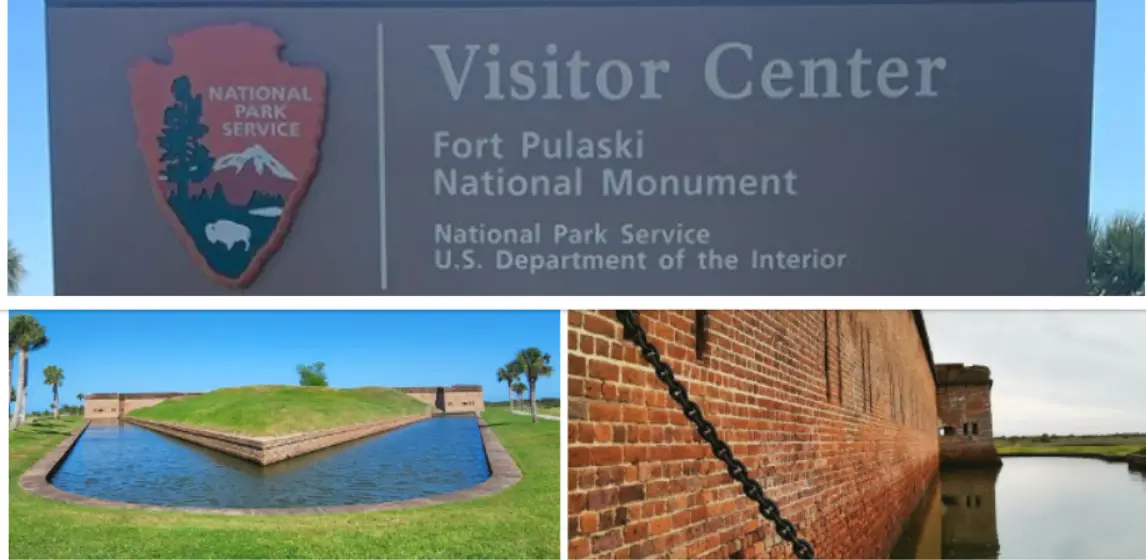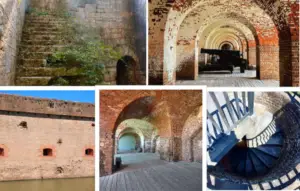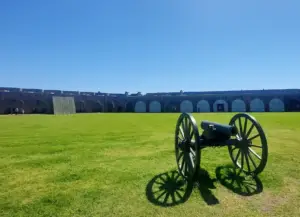Fort Pulaski National Monument : Interesting Facts, History & Travel Guide

- By
- Aparna Patel
- |
- 1 Apr, 2023
- |

Fort Pulaski National Monument, located on Cockspur Island in Georgia, is a historic fort that played a significant role in the American Civil War. The fort was built between 1829 and 1847 to protect the Savannah River and the city of Savannah from foreign invasion. However, it was during the Civil War that the fort gained its notoriety.
In 1862, during the Union Army’s campaign to take control of the Confederate-held city of Savannah, they bombarded and ultimately captured Fort Pulaski in one of the most significant military engineering feats of the war.
Today, Fort Pulaski National Monument is a popular tourist destination, attracting visitors from around the world who come to learn about its rich history and experience its natural beauty.
In this article, we will explore the interesting facts, history, and travel guide of Fort Pulaski National Monument.
Table of Contents
Interesting facts about Fort Pulaski National Monument
- Fort Pulaski was named after Count Casimir Pulaski, a Polish nobleman who fought in the American Revolution and died in the Battle of Savannah.
- The construction of Fort Pulaski began in 1829 and was completed in 1847. It was built to protect the city of Savannah from naval attacks.
- During the American Civil War, Fort Pulaski was captured by Union forces in 1862 after a 30-hour siege. This marked a turning point in military history, as it was the first time rifled artillery was used in a siege.
- The Union army used the fort as a prison for Confederate soldiers, including the famous “Immortal 600” who were transferred to Fort Pulaski in 1864.
- Fort Pulaski was decommissioned in 1889 and became a national monument in 1924. It is now managed by the National Park Service.
- The fort is home to a diverse range of plant and animal species, including alligators, egrets, and bald eagles.
- Visitors can explore the fort and its surrounding areas through a variety of activities, such as guided tours, birdwatching, and hiking trails.
- Fort Pulaski is believed to be haunted by the ghosts of soldiers who died during the Civil War. Many visitors have reported seeing apparitions and experiencing strange occurrences while visiting the fort.
- The fort is also famous for its brick walls, which were built using a unique construction method called the “Columbiad system.” This involved using layers of bricks and mortar to create a structure that was resistant to enemy fire.
- In addition to its historical and cultural significance, Fort Pulaski is also an important ecological site, as it serves as a habitat for many rare and endangered species.
Information & History of Fort Pulaski National Monument
Fort Pulaski National Monument is a historic site located on Cockspur Island, near Savannah, Georgia. It was built in the 19th century to protect the city of Savannah from naval attacks and played an important role during the American Civil War.
Construction of Fort Pulaski began in 1829 and was completed in 1847. The fort was named after Count Casimir Pulaski, a Polish nobleman who fought in the American Revolution and died in the Battle of Savannah. The fort’s design was based on the “Third System” of coastal defense, which was developed by the United States Army Corps of Engineers in response to the threat of British naval attacks during the War of 1812.
Fort Pulaski was designed to be an impenetrable fortress, with walls made of brick and mortar that were seven and a half feet thick. It was armed with a variety of heavy artillery, including smoothbore cannons, and was considered to be one of the most advanced fortifications of its time.
During the American Civil War, Fort Pulaski played a crucial role in the Union’s blockade of the Confederacy. In April 1862, Union forces under the command of General Quincy Adams Gillmore launched a surprise attack on the fort, using newly developed rifled artillery to breach the walls. The Confederate garrison, under the command of Colonel Charles H. Olmstead, surrendered after a 30-hour siege, marking a turning point in military history.
After the war, Fort Pulaski was used as a prison for Confederate soldiers, including the famous “Immortal 600” who were transferred to Fort Pulaski in 1864. The fort was decommissioned in 1889 and became a national monument in 1924. It is now managed by the National Park Service and is open to visitors year-round.
Today, visitors to Fort Pulaski can explore the fort and its surrounding areas through a variety of activities, including guided tours, birdwatching, and hiking trails. The fort is also home to a diverse range of plant and animal species, including alligators, egrets, and bald eagles.
Travel Guide for Fort Pulaski National Monument
If you are planning a trip to Fort Pulaski National Monument, here’s a travel guide to help you make the most of your visit:
- Getting there: Fort Pulaski is located on Cockspur Island, about 15 miles east of Savannah, Georgia. The park is easily accessible by car, with ample parking available on-site.
- Admission: There is an entrance fee to enter the park, which varies depending on the time of year. The fee includes access to the fort, the visitor center, and the surrounding trails and exhibits.
- Visitor Center: Start your visit at the visitor center, where you can learn about the history of the fort and the surrounding area. There are exhibits on the fort’s construction, its role in the Civil War, and its significance as a national monument.
- Fort Tours: Guided tours of the fort are available throughout the day, led by park rangers who provide historical context and insights into the fort’s design and construction. The tours are included in the admission fee.
- Hiking Trails: Fort Pulaski has several hiking trails that allow visitors to explore the surrounding area, including the McQueen’s Island Trail, which follows an old railroad bed through salt marshes and past Civil War-era earthworks.
- Birdwatching: The park is home to a variety of bird species, including egrets, herons, and bald eagles. Bring binoculars and a birding guide to spot these beautiful creatures in their natural habitat.
- Picnic Area: The park has a designated picnic area with tables and grills, making it a great spot for a picnic lunch or a break from exploring the fort.
- Visitor Services: The park has a gift shop where you can purchase souvenirs and books about the fort and the surrounding area. Restrooms and drinking fountains are also available on-site.
- Plan for Weather: Fort Pulaski can be quite hot and humid during the summer months, so plan accordingly with sunscreen, hats, and plenty of water. In the winter, temperatures can be cooler, so bring layers and check for park closures due to inclement weather.
- Nearby Attractions: The park is located near several other historic sites and natural areas, including the Tybee Island Light Station and Museum, the Savannah Historic District, and the Okefenokee Swamp. Consider adding these attractions to your itinerary if you have time.
Read More:
- Fort Ord National Monument : Interesting Facts, History & Travel Guide
- Fort Monroe National Monument : Interesting Facts, History & Travel Guide
- Fort McHenry National Monument : Interesting Facts, History & Travel Guide
- Fort Matanzas National Monument : Interesting Facts, History & Travel Guide
- Florissant Fossil Beds National Monument : Interesting Facts, History & Travel Guide
- Fort Frederica National Monument : Interesting Facts, History & Travel Guide
- Yosemite National Park: Interesting Facts, History & Information
Some frequently asked questions about Fort Pulaski National Monument:
When was Fort Pulaski built?
Construction of Fort Pulaski began in 1829 and was completed in 1847.
What is the significance of Fort Pulaski in the Civil War?
During the American Civil War, Fort Pulaski played a crucial role in the Union’s blockade of the Confederacy. In April 1862, Union forces under the command of General Quincy Adams Gillmore launched a surprise attack on the fort, using newly developed rifled artillery to breach the walls. The Confederate garrison, under the command of Colonel Charles H. Olmstead, surrendered after a 30-hour siege, marking a turning point in military history.
What can visitors do at Fort Pulaski National Monument?
Visitors to Fort Pulaski can explore the fort and its surrounding areas through a variety of activities, including guided tours, birdwatching, and hiking trails. The fort is also home to a diverse range of plant and animal species, including alligators, egrets, and bald eagles.
Is there an admission fee to enter Fort Pulaski National Monument?
Yes, there is an entrance fee to enter the park, which varies depending on the time of year.
Can visitors bring food into the park?
Yes, visitors are welcome to bring food and drinks into the park. There is a designated picnic area with tables and grills.
Are pets allowed in Fort Pulaski National Monument?
Pets are allowed in the park, but they must be on a leash and under the owner’s control at all times. They are not allowed in the visitor center or on the guided tours of the fort.
Is Fort Pulaski National Monument accessible for people with disabilities?
Yes, the park is accessible for people with disabilities. The visitor center and fort have wheelchair ramps and accessible restrooms.
Search Posts
Latest posts
-
4 Mar, 2024
Can I accidentally miss the in-flight food?
-
5 Mar, 2024
Passing through airport security with autism
Popular posts
-
5 Mar, 2024
Why prohibit engine braking?
